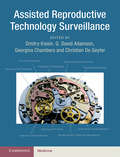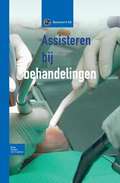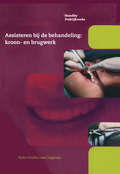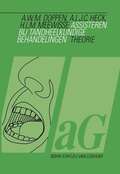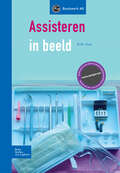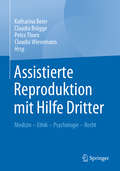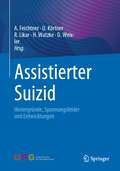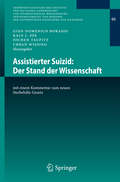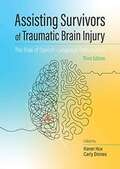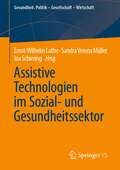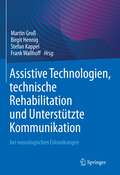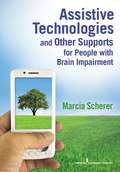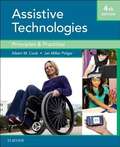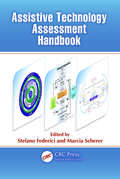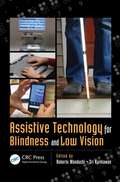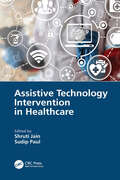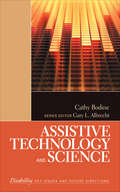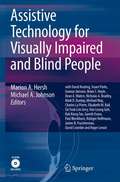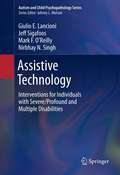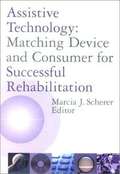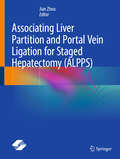- Table View
- List View
Assisted Reproductive Technology Surveillance
by G. David Adamson Dmitry M. Kissin Georgina Chambers Christian De GeyterFor over forty years, assisted reproductive technology (ART) has helped millions of patients around the world to overcome infertility. Careful monitoring of ART treatments and their outcomes is vital to maintain the remarkable pace of change in science and technology, whilst minimizing potential risks to infertility patients, and their children. Written by forty-five authors from twenty countries around the world, this book represents a global effort to document the history of assisted reproductive technology surveillance, and its dynamic challenges across the world. Comprehensive in its approach, the text details best practices in collecting and using ART surveillance data to monitor treatment effectiveness and safety, improve quality of care, develop health policy, and provide accurate information to infertility patients, worldwide.
Assisted Suicide and the European Convention on Human Rights (Biomedical Law and Ethics Library)
by Stevie MartinLocating assisted suicide within the broader medical end-of-life context and drawing on the empirical data available from the increasing number of permissive jurisdictions, this book provides a novel examination of the human rights implications of the prohibition on assisted suicide in England and Wales and beyond. Assisted suicide is a contentious topic and one which has been the subject of judicial and academic debate internationally. The central objective of the book is to approach the question of the ban’s compatibility with the European Convention on Human Rights afresh; freed from the constraints of the existing case law and its erroneous approach to the legal issues and selective reliance on empirical data. The book also examines the compatibility of the ban on assisted suicide with rights which have either been erroneously disregarded or not considered by either the domestic courts or the European Court of Human Rights. Having regard to human rights jurisprudence more broadly, including in the context of abortion, the research and analysis undertaken here demonstrates that the ban on assisted suicide violates the rights of a significant number of individuals to life, to freedom from torture or inhuman or degrading treatment and to private life. Such analysis does not depend on a strained or contrived approach to the rights at issue. Rather, the conclusions flow naturally from a coherent, logical application of the established principles governing those rights. While the focus of the book is the Suicide Act 1961, the conclusions reached have implications beyond England and Wales, including for the other devolved jurisdictions and international jurisdictions. Beyond courts and legislators, it will be a valuable resource for students of human rights and medical law, as well as medical and legal practitioners and academics working in human rights and end-of-life care.
Assisteren bij behandelingen
by D. M. VoetDit boek biedt ondersteuning aan tandartsassistenten in opleiding en aan reeds werkzame assistenten die kennis willen nemen van het behandelconcept four-handed dentistry. Werken volgens de richtlijnen van dit concept vormt de basis voor een efficiënte en plezierige werksituatie die een rustgevende en professionele uitstraling heeft op de patiënt. Dit komt het welzijn van zowel patiënten als teamleden ten goede en zal de kwaliteit van de geboden tandheelkundige zorg verhogen.Assisteren bij behandelingen besteedt verder aandacht aan het verkeken van tandheelkundige materialen en bevat een groot aantal protocollen voor de tandartsassistent. Daarin worden de meest voorkomen de behandelingen in de tandartspraktijk stap voor stap uitgewerkt aan de hand van full colour afbeeldingen. De bijgeleverde cd-rom bevat videofragmenten van de 10 meest voorkomende behandelingen van assisteren aan de stoel. Deze uitgave vormt één geheel net het boek Assisteren in beeld. Beide boeken omvatten gezamenlijk in word en beeld de belangrijkste kerntaak van tandartsassistenten: het assisteren bij tandheelkundige behandelingen.
Assisteren bij de behandeling: kroon- en brugwerk (Standby praktijkreeks)
by A. AkkerVervaardigen van kronen en bruggen is een technisch ingewikkelde behandeling. Voor het slagen van de behandeling, is het van groot belang dat de assistente de tandarts op een goede manier kan bijstaan. Dit deel uit de Standby Praktijkreeks is voor de assistente daarbij een onmisbare steun. In de eerste plaats omdat een goed algemeen overzicht wordt gegeven van de gang van zaken bij deze behandeling. Daarnaast biedt het boek belangrijke tips en trucs voor de behandeling. Tevens wordt de communicatie met de tandtechnicus en de patiënt toegelicht. Met de kennis die dankzij dit boek op deze gebieden wordt opgedaan, zal de tandartsassistente de tandarts beter kunnen ondersteunen en ook moeilijke situaties en problemen veel beter de baas kunnen. Zoals bij praktische onderpen als deze hoort, is de informatie gebaseerd op situaties uit de dagelijkse praktijk. De gepresenteerde casuïstiek en theorie zijn bovendien rijk voorzien van foto"s. Tandartsassistenten (in opleiding), maar ook de tandarts zelf en de mondhygiënisten, kunnen zich zo een uitstekend beeld vormen van alle facetten van de behandeling en de verworven kennis direct in de praktijk toepassen
Assisteren bij tandheelkundige behandelingen: Theorie
by A.W.M. Doppen A.L.J.C. Heck H.L.M. MeewisseAssisteren bij tandheelkundige behandelingen behandelt de basisvaardigheden van de tandartsassistente. Aan de orde komen onder andere de anatomie en fysiologie van hoofd, hals en kauwstelsel, hygiëne, arbeidsomstandigheden, endodontie, parodontologie, orthodontie, implantologie, röntgenologie, mond- en kaakchirurgie en geneesmiddelen. Ook worden restauratieve, preventieve en prothetische tandheelkunde behandeld.
Assisteren in beeld
by D. M. VoetInclusief cd–rom met videofragmenten van (basis)handelingen van de tandartsassistent!Een tandartsassistent is een onmisbare kracht in de tandartspraktijk. De kerntaken van het werk zijn vastgelegd in het Eindconcept Kwalificatiedossier Tandartsassistent. In Assisteren in beeld, staat de derde kerntaak centraal: assisteren bij tandheelkundige behandelingen. Het boek bestaat uit drie delen. Het eerste deel bevat een beknopte theoretische inleiding in woord en beeld, waarin algemene begrippen en de anatomie van het gebit aan de orde komen. Het tweede deel behandelt in alfabetische volgorde de instrumenten, apparatuur en materialen die nodig zijn voor het assisteren bij tandheelkundige handelingen. Dit deel is bovendien rijkelijk geïllustreerd met kleurenafbeeldingen. In het derde deel vindt u tot slot een toelichting op de videofragmenten die op cd–rom zijn meegeleverd. In deze fragmenten wordt het assisteren aan de stoel op heldere wijze in beeld gebracht.
Assistierte Reproduktion mit Hilfe Dritter: Medizin - Ethik - Psychologie - Recht
by Claudia Wiesemann Petra Thorn Katharina Beier Claudia BrüggeSammelband mit Beiträgen von 28 Expertinnen und Experten aus dem Bereich der assistierten Reproduktion.Immer häufiger werden Verfahren der medizinisch assistierten Reproduktion genutzt, die den Beitrag Dritter einschließen, also Samenspende, Eizellspende, Embryospende oder Leihmutterschaft. Diese Formen der Familienbildung mit Hilfe Dritter werfen ein breites Spektrum an medizinischen, ethischen, rechtlichen und lebensweltlichen Fragen auf, die umfassend und im interdisziplinären Kontext diskutiert werden sollten. In diesem Sammelband mit Beiträgen in deutscher und englischer Sprache diskutieren Expertinnen und Experten aus unterschiedlichen fachlichen und lebensweltlichen Perspektiven Probleme und Lösungsansätze. Empirische Analysen aus der internationalen Forschung und Praxisbeispiele aus Großbritannien, USA, Australien und Neuseeland ergänzen die Darstellung.
Assistierter Suizid: Hintergründe, Spannungsfelder und Entwicklungen
by Rudolf Likar Angelika Feichtner Ulrich Körtner Herbert Watzke Dietmar WeixlerDie Legalisierung der Beihilfe zum Suizid bringt tiefgreifende gesellschaftliche Veränderungen mit sich. Das bisherige Selbstverständnis von Medizin und Pflege wird in Frage gestellt und es wird eine neue Auseinandersetzung mit dem Leid am Lebensende erfordern. Das Buch bietet einen Überblick über die ethischen Aspekte und die internationalen Entwicklungen der Suizidassistenz sowie über die Spannungsfelder, die sich durch die Legalisierung der Beihilfe zum Suizid aus der Sicht von Palliative Care ergeben. Die Entwicklungen in anderen Ländern, in denen Suizidassistenz schon länger legal ist, geben Anlass zur Sorge. Es wird entscheidend sein, wie gut es gelingt, Rahmenbedingungen festzulegen, die gewährleisten, dass der Entschluss für einen assistierten Suizid frei von Druck getroffen wird. Das Buch richtet sich an alle Berufsgruppen, die Patienten am Lebensende behandeln oder betreuen und schwierige Entscheidungen treffen müssen, sowie an ethischen Themen Interessierte.
Assistierter Suizid: mit einem Kommentar zum neuen Sterbehilfe-Gesetz (Veröffentlichungen des Instituts für Deutsches, Europäisches und Internationales Medizinrecht, Gesundheitsrecht und Bioethik der Universitäten Heidelberg und Mannheim #46)
by Jochen Taupitz Ralf J. Jox Gian Domenico Borasio Urban WiesingDas Buch dokumentiert die Beitr#65533;ge des internationalen Symposiums ,,Assistierter Suizid: Der Stand der Wissenschaft" vom 15. Juni 2015 in Berlin. Es bietet einen einmaligen #65533;berblick #65533;ber die aktuellen empirischen Untersuchungen zum Thema, die in der politischen Debatte teilweise schlicht ignoriert wurden und immer noch ignoriert werden. Es enth#65533;lt au#65533;erdem die Transkripte aufschlussreicher Pro-Contra Debatten zwischen Vertretern unterschiedlicher Positionen aus den Fachgebieten Recht, Medizin und Ethik. Am Schluss steht eine ausf#65533;hrliche Kommentierung des neuen Gesetzes ,,zur Strafbarkeit der gesch#65533;ftsm#65533;#65533;igen F#65533;rderung der Selbstt#65533;tung" aus rechtlicher, medizinischer und ethischer Perspektive. Die Autoren und Herausgeber sind international ausgewiesene Experten aus Deutschland und aus anderen Staaten, in denen die T#65533;tung auf Verlangen und/oder der assistierte Suizid gesetzlich geregelt sind (Niederlande, Schweiz, USA).
Assisting Survivors Of Traumatic Brain Injury: The Role Of Speech-language Pathologists
by Karen Hux Carly DinnesHow does one help people with traumatic brain injury when often it is essentially a “hidden disability” and the person affected is virtually indistinguishable from noninjured people? This book prepares graduate students and practicing speech–language pathologists for serving people with TBI. This third edition includes examples of interprofessional collaboration; new chapters relating specifically to assessment procedures and evidence-based interventions regarding cognitive-communication disorders, including sections on reading and writing; psychosocial and mental health concerns; postsecondary pursuits for young adults with TBI; and ethical considerations for working with people with TBI. It is organized into three sections: 1. Understanding Traumatic Brain Injury: Includes definitions, epidemiology, injury severity, mechanisms of injury, and interprofessional practice. 2. Understanding the Role of Speech–Language Pathologists: Discusses the major disorders associated with TBI, including disorders of consciousness, cognitive-communication disorders, AAC assessment and intervention, and dysarthria associated with TBI. 3. Understanding Reintegration: Provides guidance regarding pertinent issues and effective methods of transitioning survivors into family, community, educational, and vocational settings. Many survivors of TBI, along with their families, share real-life stories and experiences in this book.
Assistive Technologien im Sozial- und Gesundheitssektor (Gesundheit. Politik - Gesellschaft - Wirtschaft)
by Sandra Verena Müller Ernst-Wilhelm Luthe Ina SchieringInwiefern kann die Verwendung assistiver Technologien im Sozial- und Gesundheitssektor eine Antwort sein auf drängende Fragen des demografischen Wandels, des sektoralen Fachkräftemangels und der gesellschaftlichen Teilhabe vulnerabler Personen? Sind sie ein wünschenswerter Beitrag zur Selbstbestimmung und Erhöhung der Versorgungssicherheit der Bevölkerung oder eine fatale Entwicklung hin zu einer Ökonomisierung unserer Hilfesysteme? Das Buch nimmt hierzu Stellung aus unterschiedlichen Richtungen: medizinisch, psychologisch, ökonomisch, rechtlich, gesellschaftswissenschaftlich und aus Sicht der Informatik. Mit seinem Erscheinen in der Reihe „Gesundheit. Politik-Gesellschaft-Wirtschaft“ (hrsg. von E.-W. Luthe und J.N. Weatherly) steht das Buch für die wachsende Erkenntnis, Gesundheitspolitik als interdisziplinäre Aufgabe zu betrachten.
Assistive Technologien, technische Rehabilitation und Unterstützte Kommunikation: bei neurologischen Erkrankungen
by Martin Groß Birgit Hennig Stefan Kappel Frank WallhoffDas interdisziplinäre Grundlagenwerk informiert aus der Perspektive von Neurologie, Rehabilitation, Ingenieurwesen, Pädagogik und Physiotherapie sowie aus Sicht der Patienten über Möglichkeiten und Grenzen des Einsatzes von Technik, um die Teilhabe neurologisch erkrankter Menschen zu verbessern. Ziel des Buches ist, allen Berufsgruppen, die an der Behandlung schwer und komplex erkrankter neurologischer Patienten beteiligt sind, ein umfassendes Verständnis assistiver und rehabilitativer Technologien zu vermitteln.
Assistive Technologies and Environmental Interventions in Healthcare: An Integrated Approach
by Lynn Gitlow Kathleen FleckyProviding a holistic and client-centered approach, Assistive Technologies and Environmental Interventions in Healthcare explores the individual’s needs within the environment, examines the relationship between disability and a variety of traditional and cutting-edge technologies, and presents a humanistic discussion of Technology-Environment Intervention (TEI). Written by a multidisciplinary team of authors, this text introduces readers to a variety of conceptual practice models and the clinical reasoning perspectives. It also provides insight into how designers go about solving human-tech problems, discusses best practices for both face-to-face and virtual teams, and looks at the psychological, sociocultural, and cognitive factors behind the development and provision of assistive technologies. Examines a wide range of technologies and environmental interventions Demonstrates how a better understanding of the complexity of human interaction with both the physical and social environment can lead to better use of technology Explores the future of technology and research in TEI Complete with a range of learning features such as keywords, case studies and review questions, this book is ideal for undergraduate and graduate students in occupational therapy and other related health professions, as well as those undertaking certification and board examinations.
Assistive Technologies and Other Supports for People With Brain Impairment
by Marcia J. SchererAssistive Technologies and Other Support for People with Brain Impairment, by Marcia J. Scherer, is a must-have text for academic instructors and their students. The author's synopsis of brain impairment, current rehabilitation strategies, available assistive technologies and resources, as well as the practical merging of the above, makes this an invaluable addition to any academic program in cognitive rehabilitation. This book gives a clear and detailed overview of how the brain reacts to impairment and gives illustrated examples of effective integration of AT into the lives of people with cognitive disability. Integrating current research with the experiences of people with cognitive disabilities, this volume examines how assistive and cognitive support technologies are being harnessed to provide assistance for thinking, remembering, and learning. The book vividly describes real-life situations in which cognitively impaired individuals use assistive supports and the advantages and limitations these individuals perceive from their use. It provides information on how cognitively impaired individuals and their families and caregivers can select the most appropriate technologies from a wide array of accommodations and resources, including individualized protocols of different forms of support to facilitate optimal functioning. The text offers practitioners a comprehensive and systematic process for ensuring their clients' effective application and utilization of this technology. This book will also provide insight for users of assistive technology and their families and caregivers to ensure optimal technology use.
Assistive Technologies: Principles And Practice
by Albert M. Cook Janice Miller PolgarIt's here: the latest edition of the one text you need to master assistive strategies, make confident clinical decisions, and help improve the quality of life for people with disabilities. Based on the Human Activity Assistive Technology (HAAT) model, Assistive Technologies: Principles and Practice, 4th Edition provides detailed coverage of the broad range of devices, services, and practices that comprise assistive technology, and focuses on the relationship between the human user and the assisted activity within specific contexts. Updated and expanded, this new edition features coverage of new ethical issues, more explicit applications of the HAAT model, and a variety of global issues highlighting technology applications and service delivery in developing countries. Human Activity Assistive Technology (HAAT) framework demonstrates assistive technology within common, everyday contexts for more relevant application. Focus on clinical application guides you in applying concepts to real-world situations. Review questions and chapter summaries in each chapter help you assess your understanding and identify areas where more study is needed. Content on the impact of AT on children and the role of AT in play and education for children with disabilities demonstrates how AT can be used for early intervention and to enhance development. Coverage of changing AT needs throughout the lifespan emphasizes how AT fits into people's lives and contributes to their full participation in society. Principles and practice of assistive technology provides the foundation for effective decision-making. NEW! Global issues content broadens the focus of application beyond North America to include technology applications and service delivery in developing countries. NEW! Ethical issues and occupational justice content exposes you to vital information as you start interacting with clients. NEW! More case studies added throughout the text foster an understanding of how assistive technologies are used and how they function. NEW! Updated content reflects current technology and helps keep you current. NEW! Explicit applications of the HAAT model in each of the chapters on specific technologies and more emphasis on the interactions among the elements make content even easier to understand.
Assistive Technology Assessment Handbook (Rehabilitation Science in Practice Series)
by Marcia J. Scherer Stefano FedericiThe process of matching a person who has a disability with the most appropriate assistive technology requires a series of assessments, typically administered by multidisciplinary teams at specialized centers for technical aid. Assistive Technology Assessment Handbook fills the need for a reference that helps assistive technology experts perform ass
Assistive Technology Assessment Handbook (Rehabilitation Science in Practice Series)
by Marcia Scherer Stefano FedericiAssistive Technology Assessment Handbook, Second Edition, proposes an international ideal model for the assistive technology assessment process, outlining how this model can be applied in practice to re-conceptualize the phases of an assistive technology delivery system according to the biopsychosocial model of disability. The model provides reference guidelines for evidence-based practice, guiding both public and private centers that wish to compare, evaluate, and improve their ability to match a person with the correct technology model. This second edition also offers a contribution to the Global Cooperation on Assistive Technology (GATE) initiative, whose activities are strongly focused on the assistive products service delivery model. Organized into three parts, the handbook: gives readers a toolkit for performing assessments; describes the roles of the assessment team members, among them the new profession of psychotechnologist; and reviews technologies for rehabilitation and independent living, including brain–computer interfaces, exoskeletons, and technologies for music therapy. Edited by Stefano Federici and Marcia J. Scherer, this cross-cultural handbook includes contributions from leading experts across five continents, offering a framework for future practice and research.
Assistive Technology For Blindness And Low Vision (Rehabilitation Science In Practice)
by Roberto Manduchi Sri KurniawanAssistive technology has made it feasible for individuals with a wide range of impairments to engage in many activities, such as education and employment, in ways not previously possible. The key factor is to create consumer-driven technologies that solve the problems by addressing the needs of persons with visual impairments. Assistive Technology for Blindness and Low Vision explores a broad range of technologies that are improving the lives of these individuals. Presenting the current state of the art, this book emphasizes what can be learned from past successful products, as well as what exciting new solutions the future holds. <P><P> Written by world-class leaders in their field, the chapters cover the physiological bases of vision loss and the fundamentals of orientation, mobility, and information access for blind and low vision individuals. They discuss technology for multiple applications (mobility, wayfinding, information access, education, work, entertainment), including both established technology and cutting-edge research. The book also examines computer and digital media access and the scientific basis for the theory and practice of sensory substitution. <P><P> This volume provides a holistic view of the elements to consider when designing assistive technology for persons with visual impairment, keeping in mind the need for a user-driven approach to successfully design products that are easy to use, well priced, and fill a specific need. Written for a broad audience, this book provides a comprehensive overview and in-depth descriptions of current technology for designers, engineers, practitioners, rehabilitation professionals, and all readers interested in the challenges and promises of creating successful assistive technology.
Assistive Technology Intervention in Healthcare
by Sudip Paul Shruti JainAssistive Technology Intervention in Healthcare focuses on various applications of intelligent techniques in biomedical engineering and health informatics. It aims to create awareness about disability reduction and recovery of accidental disability with the help of various rehabilitative systems. Novel technologies in disability treatment, management and assistance, including healthcare devices and their utility from home to hospital, are described. The book deals with simulation, modeling, measurement, control, analysis, information extraction and monitoring of physiological data in clinical medicine and biology. Features Covers the latest evolutionary approaches to solve optimization problems in the biomedical engineering field Explains machine learning–based approaches to improvement in health engineering areas Reviews the IoT, cloud computing and data analytics in healthcare informatics Discusses modeling and simulations in the design of biomedical equipment Explores monitoring of physiological data This book is aimed at researchers and graduate students in biomedical engineering, clinical engineering and bioinformatics.
Assistive Technology and Science (The SAGE Reference Series on Disability: Key Issues and Future Directions)
by Cathy BodineThis volume in The SAGE Reference Series on Disability explores issues involving assistive technology engineering and science. It is one of eight volumes in the cross-disciplinary and issues-based series, which incorporates links from varied fields making up Disability Studies as volumes examine topics central to the lives of individuals with disabilities and their families. With a balance of history, theory, research, and application, specialists set out the findings and implications of research and practice for others whose current or future work involves the care and/or study of those with disabilities, as well as for the disabled themselves. The presentational style (concise and engaging) emphasizes accessibility. Taken individually, each volume sets out the fundamentals of the topic it addresses, accompanied by compiled data and statistics, recommended further readings, a guide to organizations and associations, and other annotated resources, thus providing the ideal introductory platform and gateway for further study. Taken together, the series represents both a survey of major disability issues and a guide to new directions and trends and contemporary resources in the field as a whole.
Assistive Technology for Blindness and Low Vision (Rehabilitation Science in Practice Series)
by Roberto Manduchi Sri KurniawanAssistive technology has made it feasible for individuals with a wide range of impairments to engage in many activities, such as education and employment, in ways not previously possible. The key factor is to create consumer-driven technologies that solve the problems by addressing the needs of persons with visual impairments. Assistive Technology for Blindness and Low Vision explores a broad range of technologies that are improving the lives of these individuals. Presenting the current state of the art, this book emphasizes what can be learned from past successful products, as well as what exciting new solutions the future holds.Written by world-class leaders in their field, the chapters cover the physiological bases of vision loss and the fundamentals of orientation, mobility, and information access for blind and low vision individuals. They discuss technology for multiple applications (mobility, wayfinding, information access, education, work, entertainment), including both established technology and cutting-edge research. The book also examines computer and digital media access and the scientific basis for the theory and practice of sensory substitution.This volume provides a holistic view of the elements to consider when designing assistive technology for persons with visual impairment, keeping in mind the need for a user-driven approach to successfully design products that are easy to use, well priced, and fill a specific need. Written for a broad audience, this book provides a comprehensive overview and in-depth descriptions of current technology for designers, engineers, practitioners, rehabilitation professionals, and all readers interested in the challenges and promises of creating successful assistive technology.
Assistive Technology for Visually Impaired and Blind People
by Marion A. Hersh Michael A. JohnsonEqual accessibility to public places and services is now required by law in many countries. In the case of the vision-impaired, it is often the use of specialised technology which can provide them with a fuller enjoyment of all the facilities of society from large scale meetings and public entertainments to the more personal level of reading a book or making music. In this volume the engineering and design principles and techniques used in assistive technology for blind and vision-impaired people are explained. Features:· instruction in the physiology of the human visual system and methods of measuring visual ability;· explanation of many devices designed for every-day living in terms of generic electrical engineering principles;· sections of practical projects and investigations which will give the reader ideas for student work and for self teaching;· contributions by authors of international repute from divers fields which co-operate under the banner of assistive technology, among them: artificial vision systems; psychology, haptics, electrical engineering, design and visual physiology. Assistive Technology for Vision-impaired and Blind People is an an effective means of maintaining the currency of knowledge for engineers and health workers working to provide devices and/or services for people with sight loss and an excellent source of reference for students working in assistive technology and rehabilitation.
Assistive Technology: Interventions for Individuals with Severe/Profound and Multiple Disabilities (Autism and Child Psychopathology Series)
by Mark F. O'Reilly Jeff Sigafoos Nirbhay N. Singh Giulio E LancioniFor people with severe/profound and multiple disabilities, managing the basic necessities of daily life often poses myriad challenges. Despite great odds, advances in assistive technology are making a difference in these individuals' lives. Advances in microswitches, voice outcome communication aids, and computer-based systems are creating new opportunities for living independently, improving basic life skills, and reducing problem behaviors among individuals with combined motor, sensory, and intellectual disabilities. This unique volume examines how education and rehabilitation can improve the lives of even those individuals most affected by severe/profound and multiple disabilities. Interventions currently in use and in experimental stages are surveyed in terms of how they work and their applicability to clients with various needs. In addition, it examines the characteristics of developmentally disabled populations and offers guidelines for choosing suitable technologies. It presents empirical evidence on the advances in improving interaction with caregivers, control of the home environment, handling self-care tasks, and other core skills. Assistive Technology examines interventions that are innovative, respectful of the dignity of clients, and practical for ongoing use, including: * Microswitches in habilitation programs. * Speech-generating devices for communication and social development. * Instructional technology for promoting academic, work, and leisure skills. * Assistive technology for promoting ambulation. * Orientation systems for promoting movement indoors. * Assistive technology for reducing problem behaviors. A state-of-the-art guide to a growing field, Assistive Technology is an invaluable resource for researchers, clinicians, graduate students as well as clinicians and allied professionals in developmental psychology, rehabilitation and rehabilitative medicine, learning and instruction, occupational therapy, speech-language pathology, and educational technology.
Assistive Technology: Matching Device and Consumer for Successful Rehabilitation
by Marcia J. SchererAn exploration of the ways in which psychologists and other helping professionals can collaborate with users of assistive technology to help them get the most out of these devices.
Associating Liver Partition and Portal Vein Ligation for Staged Hepatectomy (ALPPS)
by Jian ZhouThis book systematically describes details in Associating liver partition and portal vein ligation for staged hepatectomy (ALPPS). The chapters focus on the development history, applied anatomy, mechanism of action, specific methods of administration of the various types of current ALPPS procedures (from classical ALPPS to various modified procedures), the preoperative evaluation, case selection (indications and contraindications), and surgical planning, as well as the postoperative management and follow-up treatment. It also introduces the progress of international research on ALPPS, as well as the ALPPS modeling of the research. It will be a helpful reference for hepatobiliary surgeons and oncologists to learn the latest theoretical and technical knowledge about ALPPS.
